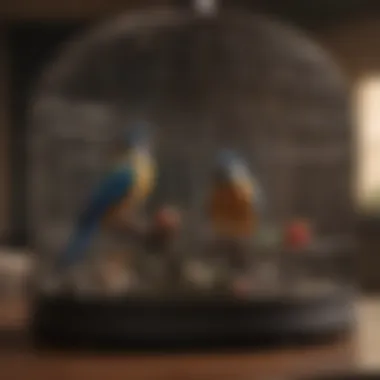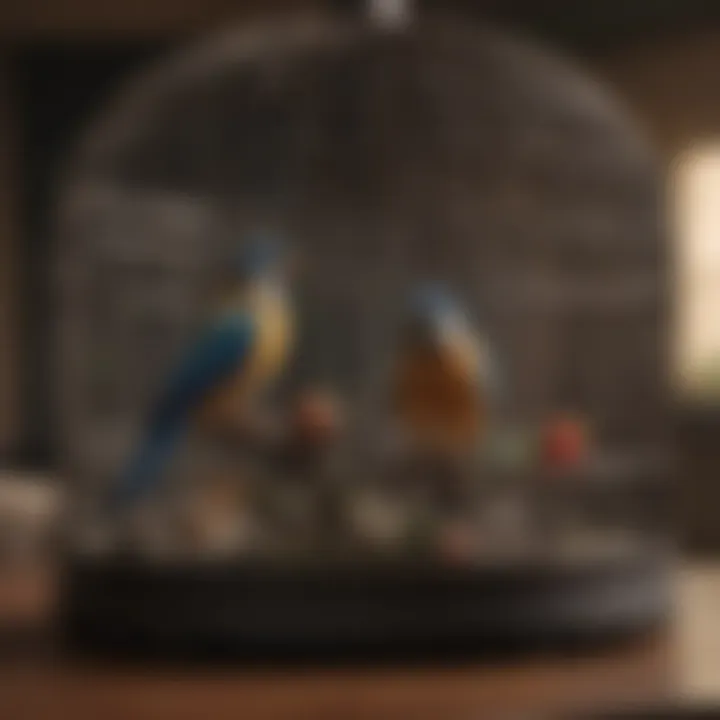Exploring Large Bird Cages: Insights for Pet Owners


Intro
Providing a spacious and well-designed habitat is crucial for pet birds. Choosing a very large bird cage can significantly impact their overall health and well-being. This section will explore various aspects of bird ownership, including understanding their needs, effective care strategies, training, and engaging activities. By considering these factors, pet owners can create an enriched environment that supports their birds.
Understanding Your Pet
Pet Behavior Basics
Understanding avian behavior is critical for fostering a positive interaction with pet birds. Birds are social creatures and need companionship, both from humans and other birds. Recognizing their vocalizations and body language helps in assessing their mood and needs. For instance, a bird that chirps frequently may be seeking attention or expressing joy.
Common Breed Characteristics
Different bird species exhibit distinct behaviors and characteristics. Parakeets, for example, are known for their playful nature, while cockatoos may display affectionate but demanding behaviors. It is important to research the specific breed to understand what they enjoy and how they socialize with their owners.
Species-Specific Needs
Various species have unique habitat and care requirements. Larger birds like macaws need ample space for flying, while smaller birds such as finches may thrive in a different setup. Consequently, choosing the right size and configuration for the cage is paramount. Researching specific species can help tailor the cage environment accordingly.
Pet Care and Maintenance
Feeding Guidelines
A balanced diet is essential for a bird's health. Most birds require a combination of seeds, pellets, fresh fruits, and vegetables. Avoid feeding them avocado and chocolate, as these items are toxic to birds. Ensure fresh water is always available and change it daily.
Grooming Essentials
Regular grooming plays a role in maintaining a bird's health. This includes trimming nails and beaks, as well as offering opportunities for bathing. Many birds enjoy occasional baths, whether in shallow bowls or in mist form from a spray bottle.
Hygiene Practices
Maintaining cleanliness in the cage is necessary to prevent illnesses. Clean the cage regularly, including perches and toys, using bird-safe cleaning products. Additionally, check for any signs of mold or spoiled food to ensure optimal living conditions.
Training and Development
Basic Commands and Skills
Training your bird to follow basic commands can enhance your relationship. Simple commands, like
Prelims to Very Large Bird Cages
The significance of very large bird cages is paramount for the health and well-being of pet birds. Providing sufficient space for birds is not just a luxury; it's a necessity. Birds are active creatures that need room to move, stretch, and explore. A spacious cage allows for natural behaviors, promoting physical and mental health.
Importance of Space for Birds
Space influences a bird's quality of life significantly. When a bird has adequate room to move, it can engage in behaviors that are essential for its physical and emotional well-being. Birds that feel cramped can exhibit stress, leading to various health issues like feather plucking or aggression. In nature, birds have vast areas to fly and forage. Artificially restricting this space can lead to unhappy and unhealthy pets.
A larger cage can also accommodate various perches, toys, and enrichment items, fostering an environment that mimics their natural habitat. Ensuring proper space aligns with the principles of responsible pet ownership. It reflects an understanding of their natural instincts and requirements for self-expression. Overall, the importance of space cannot be overstated when creating a habitat for pet birds.
Types of Birds Requiring Large Cages
Different species of birds have unique space requirements, which need to be considered when choosing a cage. Large birds such as macaws, cockatoos, and African greys typically need larger cages to thrive. These species are known for their intelligence and active nature, making them require more room to roam and engage in various activities. Smaller birds, such as parakeets or canaries, also benefit from larger cages, as they too enjoy flying and socializing with one another.
Selecting the appropriate size of a cage based on the species will lead to a happier and healthier life for your feathered friend. Always remember that the more space you provide, the more you are investing in your pet's overall quality of life.
Benefits of Very Large Bird Cages
Providing spacious habitats for birds has several advantages that significantly impact their overall well-being. These benefits encompass physical health, behavioral freedom, and social opportunities. A very large bird cage can help any bird thrive, regardless of species. Each of these areas will be discussed in detail.
Enhanced Physical Health
When birds have ample space to move, their physical health greatly improves. Exercise is essential for their well-being. In a larger cage, birds can fly, stretch their wings, and engage in natural behaviors that promote heart health and muscle function. Smaller cages can restrict movement, leading to obesity or even joint issues.
A study indicates that birds in larger spaces show a decline in weight issues. This decline correlates with more opportunities to engage in physical activity. By observing their environment, birds exercise more vigorously. Larger cages create an environment that supports this behavior.
Birds require certain dimensions to stay healthy. The cage should permit flight. Horizontally-oriented spaces allow flapping and gliding. Regular movement in a large cage can also prevent boredom, fostering an active lifestyle.
Improved Behavioral Expression
The behavioral expression of birds is often impacted by the space available to them. In a very large bird cage, they have room to exhibit a wide range of natural behaviors. This can include perching, climbing, and foraging. It is vital for their psychological health. Constricted spaces limit these behaviors, possibly causing stress or anxiety.
Birds are social creatures and naturally engage in complex interactions. A larger cage equips them with the space necessary for socialization. Birds tend to communicate and play with each other more effectively in a spacious environment. This reduces the potential for issues related to aggression or boredom.


Adopting diverse perches and toys in larger cages further encourages exploration and play. The variety enhances their behavioral repertoire, elevating their quality of life.
Social Interaction Opportunities
Social interaction is a fundamental need for birds. A very large bird cage can accommodate multiple birds or allow them to comfortably interact with their owners. The more space available, the more opportunities there are to socialize safely.
Birds thrive on companionship. If they live in a larger cage with their peers, they can interact freely, establishing social structures and hierarchies. This decreases the likelihood of solitary behaviors that can result in mental distress.
Moreover, for owners, accessibility within a large cage enables better interaction without disrupting birds’ natural dynamics. Camaraderie between birds and their families can cultivate a deeper bond, enriching everyone’s experience.
Overall, the benefits of very large bird cages extend beyond mere convenience. They encompass essential health advantages, behavioral freedoms, and opportunities for socialization that are critical for any bird's overall prosperity. By understanding these aspects, pet owners can make informed decisions that substantially enhance the lives of their feathered companions.
Choosing the Right Size and Model
Choosing the right size and model of a bird cage is crucial for ensuring your feathered friend's well-being. The dimensions of the cage significantly impact their comfort, health, and happiness. A well-sized cage allows birds to move freely, exercise, and express natural behaviors. This section will discuss understanding the spatial requirements, common dimensions for various species, and design features to consider.
Understanding Spatial Requirements
Understanding spatial requirements goes beyond the physical space of a cage. Birds need enough room to fly short distances, stretch their wings, and engage in playful activities. The larger the cage, the better it supports their physical and mental health. Lack of space can lead to stress, aggression, and even health issues. Therefore, pet owners must evaluate how much space is suitable based on their bird’s species and overall behavior.
For example, Amazon parrots require a larger cage than finches due to their size and activity levels.
In general, cages should have adequate height and width. Vertical space is especially important for climbing birds, while width supports flight. Understanding these aspects will help create a supportive environment that encourages various behaviors like play and exploration.
Common Dimensions for Various Species
When selecting a cage, knowing the common dimensions for different bird species is beneficial. Here are some general guidelines:
- Small Birds (e.g., budgies, canaries): A cage that measures at least 30 inches in length, 18 inches in depth, and 18 inches in height.
- Medium Birds (e.g., conures, cockatiels): Aim for a cage of at least 36 inches long, 24 inches deep, and 36 inches high.
- Large Birds (e.g., macaws, Amazon parrots): Look for sizes starting from 48 inches in length, 36 inches in depth, and 60 inches in height.
These dimensions provide a basic framework, but always consider the individuality of each bird. Each species has unique needs, and pet owners should also account for additional room for toys, perches, and food stations.
Design Features to Consider
Design features play a significant role in enhancing the functionality of large bird cages. Here are some important elements:
- Bar Spacing: The spacing between bars must be appropriate for the species to prevent escape or injury. Smaller birds require closer spacing.
- Removable Bottom Tray: A tray that can easily be removed for cleaning is essential for maintaining hygiene. This feature simplifies overall maintenance, making it convenient for pet owners.
- Multiple Access Points: Look for cages with multiple doors or access points. This feature allows for easier routine interactions, feeding, and cleaning.
- Perches: Perch placements should vary in thickness and texture, as this promotes natural foot health. Properly placed perches enhance comfort and enable climbing behavior.
Selecting the appropriate size and model of a bird cage is vital for fostering a good environment for avian companions. By understanding space requirements, knowing common dimensions for various species, and considering essential design features, pet owners can ensure their feathered friends thrive in a safe and engaging habitat.
Materials Used in Large Bird Cages
Understanding the materials used in large bird cages is vital for creating a safe, durable, and comfortable environment for your avian companions. The choice of materials not only affects the longevity of the cage but also plays a critical role in the health and safety of the birds inside. Making an informed decision in this area can help prevent injuries or health issues in your pets. Therefore, every potential bird owner must understand the importance of material selection and its implications.
Metal vs.
Plastic Construction
When considering materials for large bird cages, metal and plastic are the two primary options. Each comes with its benefits and drawbacks;
- Metal Cages: Metal is commonly favored due to its strength and durability. Materials like stainless steel or powder-coated metal offer excellent resistance to wear and tear. Metal cages can withstand the pets' activities, providing a long-lasting habitat. Some owners might worry about rust or corrosion. With proper care, such issues can be minimized.
- Plastic Cages: Plastic cages are lighter and often more affordable. They can be easier to clean and are usually easier to move. However, plastic may not hold up as well to more active species. Some birds, especially those that like to chew, might damage plastic over time.
In terms of aesthetics, plastic options might come in various colors and designs, appealing to some owners more than the traditional metal look. However, it's good to consider the practical needs of the birds before deciding.
Safety Considerations in Material Selection
Safety is a foremost concern when it comes to large bird cages. Different materials carry distinct risks. For instance:
- Non-toxic Materials: Ensure that any materials are free from harmful chemicals or coatings. Some metals can leach harmful substances if not properly treated. It's crucial to look for cages labeled as safe for birds, often constructed of stainless steel or powder-coated finishes.
- No Sharp Edges: Irrespective of the material, it is essential that there are no sharp edges within the cage. A sudden movement from a bird might lead to injuries. Inspect the joints and connections.
- Distance Between Bars: For safety, ensure that the spacing between the bars is appropriate for the bird species you own. Bars that are too far apart may allow escape or lead to injury.
Remember, a well-chosen material not only enhances the aesthetic appeal but directly contributes to the well-being of your birds. Safety should always come first.
Choosing the right materials for large bird cages involves balancing various factors. Owners must consider safety, durability, and the specific needs of their parrots or finches. Monitoring how the birds interact with their environment is essential, making adjustments as needed. This attentiveness helps ensure that your feathered friends thrive in a secure environment.
Environmental Enrichment in Large Cages
Environmental enrichment is a vital consideration when it comes to large bird cages. It significantly influences the well-being and behavior of pet birds. By providing enriching environments, owners can help prevent boredom and related behavioral issues that might arise from living in a confined space. Enrichment enhances the quality of life for birds, ensuring they lead more active and fulfilling lives.
Importance of Mental Stimulation
Mental stimulation is crucial for birds just as it is for humans. Birds are intelligent creatures that require engaging activities to thrive. Without sufficient stimulation, birds may exhibit signs of stress or depression. This can manifest in poor health, feather plucking, or destructive behavior. Thus, creating an environment that encourages exploration and interaction helps to foster positive mental health in pet birds.


Types of Enrichment Items
Different types of enrichment items are essential to create a stimulating environment. These items can cater to the specific needs and preferences of various bird species. Below are several key enrichment items:
Perches and Ropes
Perches and ropes offer birds varied surfaces to land on, which helps to strengthen their feet and legs. The key characteristic of these items is their diverse shapes and materials. Natural wood perches provide texture and grip, while ropes can encourage climbing and activity. Perches can be placed at different heights to create a vertical space for bird exploration. The unique feature of ropes is the ability to customize their length and position, aiding in accessibility. Overall, these items are beneficial because they promote physical exercise and tethering options for play.
Toys and Interactive Items
Toys and interactive items are another vital aspect of environmental enrichment. These items can stimulate a bird's curiosity and encourage play. The key characteristic of these toys is their design, which often includes textures and sounds that intrigue birds. Therefore, they are widely regarded as a popular choice for enrichment. Toys that require problem-solving or have hidden compartments can be especially engaging for birds. However, it is crucial to choose safe materials to avoid any potential harm. Notably, these items provide an outlet for natural instincts such as foraging and exploring.
Hiding Spots and Nests
Hiding spots and nests offer essential security and comfort for birds. The key characteristic of these features is their ability to provide a hidden retreat. Birds often seek places to feel safe and secure. Thus, adding hiding spots enriches their living space. The unique feature of nesting materials allows birds to engage in natural behaviors, which can be very fulfilling. However, care should be taken to ensure the materials used are non-toxic. Ultimately, these elements help create a cozy environment where birds can rest and feel protected.
A well-enriched environment fosters not just physical health but also emotional well-being in birds.
In summary, providing various enrichment items in large bird cages plays a crucial role in enhancing birds' lives. From mental stimulation to the physical activity, these features help maintain a stimulating and balanced habitat that promotes overall health.
Placement of Very Large Bird Cages
Placement of very large bird cages is crucial for the happiness and well-being of your feathered companions. Positioning affects not only the birds' comfort but also their health. An ideal location can enhance their environment and contribute to a stimulating atmosphere.
To maximize the benefits of your large bird cage, you should consider various factors. A thoughtful approach to placement will ensure that your birds thrive in their habitat and enjoy a rich quality of life. This section aims to shed light on important elements regarding the placement of these cages.
Ideal Locations Within the Home
When determining where to place a large bird cage, take into account your home's layout and your birds’ needs. Your birds require a good view of activity in the home. Positioning the cage in a central area allows the birds to observe family interactions. This interaction provides social stimulation, which is important for their emotional health. Avoid placing the cage in dark corners or isolated rooms where your birds can feel lonely.
Additionally, consider placing the cage near windows for natural light. However, ensure it is away from drafts and direct sunlight for long periods since extreme temperatures can be harmful. The placement should allow easy access for you as an owner, making day-to-day care less cumbersome.
- Avoid High-Traffic Areas: Do not locate the cage where it can easily be knocked over or disturbed by frequent movement.
- Consider the Floor Level: Placing the cage higher might give a better view but can be less safe than lower options. Birds can easily escape if the cage door is left open.
- Social Interaction: Consider locations that can facilitate interaction between birds and family members.
Considerations for Natural Light and Ventilation
Natural light is a critical aspect of a bird’s habitat. It not only increases the visibility within the cage but also promotes natural behaviors. However, you must strike a balance to avoid overheating.
Ventilation is equally important when placing your cage. Ensure that air can circulate freely around the cage. This helps in keeping the environment fresh and cool, preventing the buildup of odors and bacteria, which can harm your birds.
Key points to remember include:
- Indirect Sunlight: Try to position the cage so that it receives indirect sunlight throughout the day. This helps in providing warmth without causing distress.
- Open Windows: If you decide to place the cage near windows, keep in mind to open them when the weather allows for fresh air but be cautious of drafts.
- Avoid Hazards: Make sure placing the cage by the window does not expose your birds to any risks from outside, like predators or sudden temperature changes.
In summary, the placement of very large bird cages plays an integral role in ensuring your birds live healthy, enriched lives. Following these guidelines will aid in creating a safe, comfortable, and stimulating environment for your avian companions.
Maintenance of Large Bird Cages
Maintaining large bird cages is essential for the health and comfort of your feathered companions. The quality of life for birds directly correlates with the environment they inhabit. Regular maintenance ensures their habitat remains clean, safe, and stimulating. Pet owners must understand that neglecting cage maintenance can lead to health problems for their birds. A clean environment prevents diseases, promotes avian well-being, and enhances the bird's behavior. All of these factors contribute to a happier, healthier pet.
Cleaning and Hygiene Practices
Cleaning practices for large bird cages involve several steps. First, routine cleaning should be part of a regular schedule. Feces, food remnants, and other debris should be removed daily. A mixture of warm water and mild, bird-safe disinfectant can be used for deeper cleaning once a week.
Here are some key cleaning tips:
- Use safe cleaning products: Avoid harsh chemicals. Instead, opt for products specifically designed for birds.
- Remove and clean accessories: Perches, toys, and food dishes should be washed thoroughly, as they can harbor bacteria.
- Check for wear: Inspect all components of the cage for damage. Replace any worn or broken parts as needed.
- Sanitize surfaces: Ensure all surfaces are free from bacteria. A simple vinegar solution can work well for deep cleaning.
Implementing consistent cleaning practices supports a healthier living space.
Monitoring Cage Condition
Monitoring the condition of the large bird cage is just as vital as cleaning. Regular inspections can identify issues before they become serious problems. Look for signs of wear and tear, rust, or any sharp edges. These could pose potential hazards to your birds.
To effectively monitor cage conditions, consider the following:
- Think about the material: Metal cages should be monitored for rust, while plastic parts may require replacement if damaged.
- Observe behavioral signs: Changes in your bird’s behavior, such as excessive stress or lethargy, may indicate issues with their environment.
- Temperature and humidity checks: Make sure the cage maintains a conducive climate. If the environment is too humid, it can encourage mold growth.
- Regularly assess safety features: Ensure lock mechanisms are functional to prevent escape or injury.
By focusing on proper maintenance and monitoring practices, pet owners can ensure their large bird cages provide a safe haven for their birds.
Safety Considerations


When it comes to very large bird cages, safety holds paramount importance for both the birds and their owners. Ensuring that the cage environment is secure minimizes the risk of accidents and injuries. Bird cages are not just enclosures; they are habitats that must prioritize the well-being of their avian occupants. An awareness of potential hazards is crucial, as well as selecting accessories that promote safety.
Potential Hazards in Large Cages
A variety of hazards can occur in large bird cages, which can jeopardize the health and safety of pet birds. Some common hazards to be aware of include:
- Sharp Edges: Any metal components or wooden parts may have sharp edges that can injure birds. Regular inspection for wear and tear is wise.
- Small Spaces: Areas where a bird can get stuck are problematic. Pay attention to openings and gaps, ensuring they are suitably sized for the type of bird.
- Toxic Materials: Certain paints, wood finishes, and plastics can release toxic fumes. Always check for materials that may be harmful when heated or chewed.
- Improper Caging Accessories: Accessories like ladders may pose risks. If poorly designed, they can collapse or create a hazard for climbing.
It’s essential to regularly check and maintain safety features in large bird cages. Every precaution ensures a secure living space for your pets.
Choosing Safe Accessories
Selecting the right accessories for large bird cages should be approached with care. Not only should these items enhance the living environment, but they also need to be safe and reliable. Here are key factors to consider:
- Material Selection: Ensure that accessories made from natural wood or stainless steel. Avoid items with painted surfaces prone to flaking.
- Size Appropriateness: Choose accessories that are suitable for your bird’s size. Items that are too small can lead to accidents and injuries.
- Ease of Cleaning: Select items that can be cleaned easily to maintain hygiene in the cage. This is important for the overall health of the birds.
- Durability: Opt for well-constructed items designed to withstand wear and tear. Fragile accessories can become dangerous if they break and splinter.
Proper selections and regular assessments of accessories are critical. It helps to provide a safe haven for your birds as they explore and express natural behaviors.
Safety is a primary concern. Taking the time to review and update safety aspects of large bird cages is beneficial for both the bird and the owner, ensuring a harmonious living space.
Accessibility Features in Large Bird Cages
The inclusion of accessibility features in large bird cages is essential for promoting interaction between birds and their owners. When a cage is designed with accessibility in mind, it fosters a stronger bond and makes everyday maintenance easier. Pet owners often overlook this aspect, but it plays a crucial role in ensuring the well-being of both the birds and their caretakers.
Designing for Owner Interaction
To encourage positive interaction between birds and owners, the cage design must prioritize accessibility. Easy access for cleaning and feeding can dramatically improve the experience for the pet owner. If a bird cage is difficult to navigate, it can lead to neglect in care. Thus, user-friendly features become vital.
Consideration should be given to the placement of food and water dishes. They should be situated on platforms that are reachable without entering the cage, which can stress the bird. Doors should be easily operable, perhaps with one-hand opening mechanisms. Incorporation of removable trays aids in the cleaning process, reducing the likelihood of spills when handling waste.
Toys and perches should also be positioned so that owners can easily access them for replacement or cleaning. This encourages regular interaction, which is important for the bird's mental stimulation and overall health.
Positioning for Ease of Access
The physical placement of a large bird cage in the home has significant implications for how easily owners can access it. A cage strategically located at a comfortable height facilitates effortless interaction. It should be placed where the family gathers, ensuring that the birds receive social interaction regularly.
Accessibility considerations include:
- Height of the cage: Ensure it is not too high to reach easily.
- Location in the room: Place it where it is visible and easy to interact with, yet safe from distractions or hazards.
- Proximity to outlets: If any electronic accessories are used, such as heating pads, it is prudent to position the cage near power sources.
By thoughtfully considering these placement aspects, bird owners can maintain a nurturing environment. This rapport can lead to healthier, happier birds that thrive on interaction and care.
Ensuring accessibility in bird cages not only enhances the everyday interactions but also plays a critical role in avian welfare and owner satisfaction.
Cost Considerations
When selecting a very large bird cage, understanding cost considerations is vital for any pet owner. The financial aspect can greatly influence the decision-making process when it comes to acquiring a spacious and suitable habitat for birds. It is not just about affording the cage, but also evaluating its long-term value concerning quality, durability, and the health of the birds. A well-chosen cage can offer a better habitat and elevate the quality of life for your avian companions.
Understanding Pricing Variability
Pricing for large bird cages varies significantly based on several factors. These factors include brand reputation, materials used, and specific design features. Cages made of high-quality stainless steel often command a higher price compared to plastic alternatives. Stainless steel provides durability and is resistant to rust and corrosion, making it a more reliable choice in the long term.
Another reason for variability in pricing lies in the added features of the cage. Some models include mobile stands, modular designs, or integrated play areas. On the other hand, simplistic cages with basic functionalities typically come at a lower cost. Thus, carefully considering these details will help pet owners assess what aligns best with their budget and avian needs.
Balancing Quality and Affordability
While cost is a crucial aspect, balancing quality and affordability is necessary for responsible pet ownership. A lower-priced cage might be enticing, but it is essential to reflect on the potential downsides. Inadequate materials may lead to rapid wear and tear and compromise the safety and health of the birds. Investing in a quality cage can prevent these issues, ensuring the birds have a secure and comfortable environment to thrive.
Owning a large bird cage is a long-term commitment. Thus, it may be prudent to prioritize quality over price. One effective strategy is to compare options. Research brands and read user reviews on platforms like Reddit and Facebook. Often, purchasing from a reputable dealer may slightly increase initial costs but can result in long-term savings due to durability and lower replacement rates.
Deciding on a cage must factor in both initial purchase cost and future expenses, such as maintenance and potential replacements.
In summary, acknowledging price variability is essential. However, it is equally vital to weigh the benefits of investing in a high-quality cage against the potential infractions of going for a budget option. The right approach leads to a wise investment in both the cage and the well-being of your feathered family members.
End
In this article, we have emphasized the significant role that very large bird cages play in the lives of pet birds. The importance of offering ample space cannot be overstated. It enhances the birds' physical health and psychological well-being. Moreover, large cages facilitate greater interaction among birds, improving their social behaviors.
Summarizing Key Points
- Benefits of Space: Larger cages contribute to better movement and exercise, which are vital for a bird's health.
- Behavioral Improvements: Birds in spacious environments exhibit less stress and more natural behaviors.
- Environmental Enrichment: Adding items like perches, toys, and hiding spots makes the cage stimulating, ensuring birds stay engaged.
- Safety and Materials: Choosing the right materials is crucial to avoid hazards and ensure a safe habitat.
- Accessibility: Features that promote easy access for owners enhance the caretaking experience.
These points are not merely suggestions but foundational elements that shape a bird's quality of life.
Final Thoughts on Bird Cage Selection
When selecting a cage, consider the specific needs of your birds. Size, design, and the materials used all contribute to their health and happiness. A well-thought-out cage is an investment in the well-being of your feathered friend.
Prioritize quality and safety when making your choice. The variety of cages can be overwhelming, yet understanding these critical elements offers clarity in decision-making.







